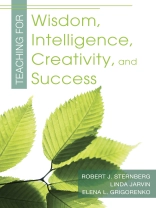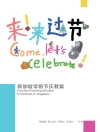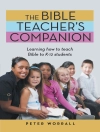‘This is a blockbuster of a book. It allows teachers to follow standards, but provides space for them to develop students′ wisdom, intelligence, and creativity (and of course success). Both teachers and students will come to understand themselves and their values better.’
—William E. Doll, Jr., Professor Emeritus
Louisiana State University
The essential guide for teaching beyond the test!
Students with strong higher-order thinking skills are more likely to become successful, lifelong learners. Based on extensive, collaborative research by leading authorities in the field, this book shows how to implement teaching and learning strategies that nurture intelligence, creativity, and wisdom.
This practical teaching manual offers an overview of the WICS model— W isdom, I ntelligence, C reativity, S ynthesized—which helps teachers foster students′ capacities for effective learning and problem solving. Teachers will find examples for language arts, history, mathematics, and science in Grades K–12, as well as:
- Hands-on strategies for enhancing students′ memory, analytical, creative, and practical skills
- Guidelines on teaching and assessing for successful intelligence
- Details on how to apply the model in the classroom
- Teacher reflection sections, suggested readings, and sample planning checklists
Teaching for Wisdom, Intelligence, Creativity, and Success is ideal for educators seeking to broaden their teaching repertoire as they expand the skills and abilities of students at all levels.
Зміст
List of Tables
About This Book
Acknowledgments
About the Authors
Section I. Teaching for Wisdom, Intelligence, and Creativity
1. Introduction to Teaching for Wisdom, Intelligence, and Creativity
2. What Is the WICS Model?
3. Your Turn: What Is Your Pattern of Strengths?
Section II. Why and How to Teach for Successful Intelligence
4. Introduction to Teaching for Successful Intelligence
5. How to Enhance Memory Skills
6. How to Enhance Analytical Skills
7. How to Enhance Creative Skills
8. How to Enhance Practical Skills
9. Your Turn: Identify Different Types of Teaching Strategies
Section III. Integrating Teaching and Assessment in Your Classroom
10. Introduction to Integrating Teaching and Assessment
11. Matching Assessment and Instruction
12. General Guidelines for Developing Diversified Assessments
13. Assessing and Rating Memory Skills
14. Assessing and Rating Analytical Skills
15. Assessing and Rating Creative Skills
16. Assessing and Rating Practical Skills
17. Your Turn: Develop Different Types of Assessment Questions
Section IV. Why and How to Teach for Wisdom
18. Introduction to Teaching for Wisdom
19. Three Wisdom-Based Thinking Skills
20. Six General Guidelines for Teaching for Wisdom
21. Reflection: How Can You Promote Wise Thinking in Your Classroom?
Section V. Synthesis: Helping Students Achieve Success and Satisfaction in Their Lives
22. Introduction to Achieving Balance
23. How to Balance It All
24. A Word of Wisdom on Learning Goals
25. Wisdom, Intelligence, and Creativity, Synthesized
Answer Keys
Appendix to Section I: Suggested Further Readings for Those Who Want to Learn More About the WICS Model and Other Resources on Teaching Strategies
Appendix to Section II: Mnemonic Techniques and Strategies
Appendix to Section III: Cross-Reference of Sample Tables by Grade, Level, Content Area, Response Format, and Cognitive Skill Assessed
References
Index
Про автора
Elena Grigorenko is associate professor of child studies and psychology at Yale University and associate professor of psychology at Moscow State University. Grigorenko has published more than 200 peer-reviewed articles, book chapters, and books. She has received many professional awards, and her research has been funded by various federal and private organizations. Grigorenko has worked with children from around the world, including those living in Africa, Asia, Europe, and the Americas.












